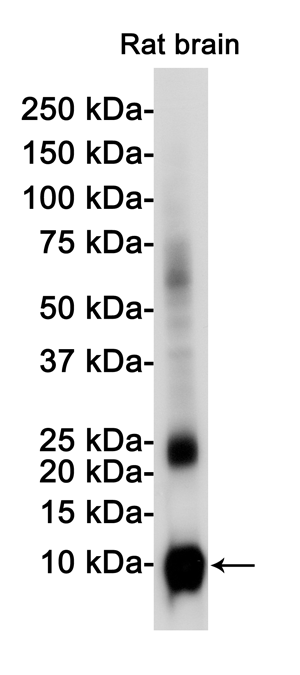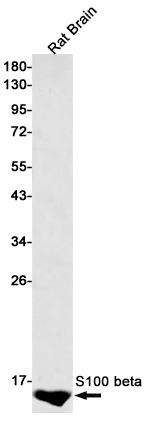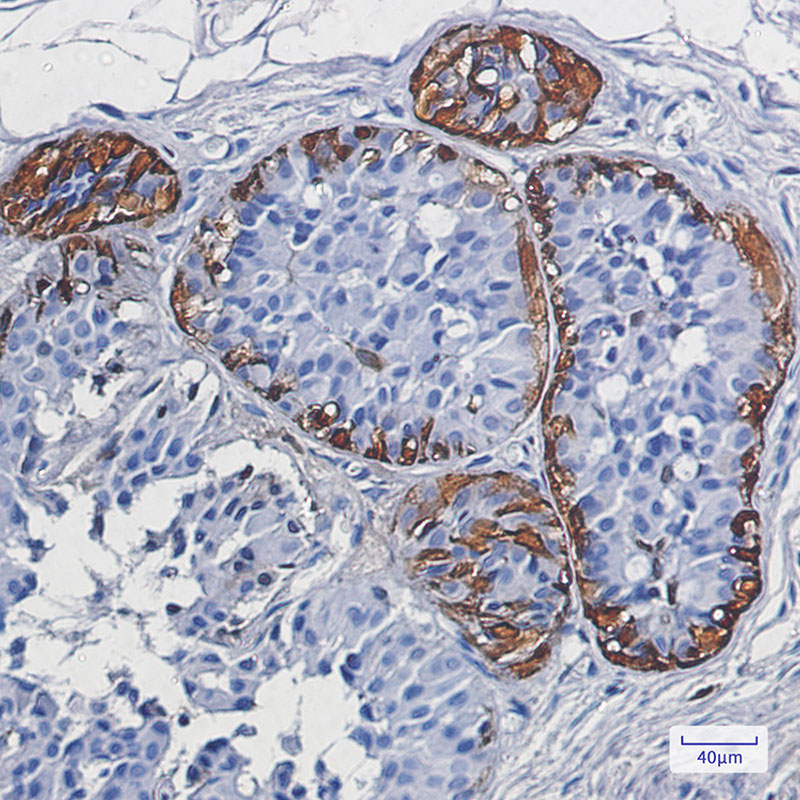


| WB | 1/500-1/1000 | Human,Mouse,Rat |
| IF | 1/20 | Human,Mouse,Rat |
| IHC | 1/50-1/100 | Human,Mouse,Rat |
| ICC | 技术咨询 | Human,Mouse,Rat |
| FCM | 咨询技术 | Human,Mouse,Rat |
| Elisa | 咨询技术 | Human,Mouse,Rat |
| Aliases | NEF; Protein S100 B; Protein S100-B; S 100 calcium binding protein beta chain; S 100 protein beta chain; S-100 protein beta chain; S-100 protein subunit beta; S100; S100 calcium binding protein beta (neural); S100 calcium-binding protein B; S100 protein beta chain; S100B; S100B_HUMAN; S100beta. |
| Entrez GeneID | 6285 |
| WB Predicted band size | Calculated MW: 11 kDa; Observed MW: 11 kDa |
| Host/Isotype | Rabbit IgG |
| Antibody Type | Primary antibody |
| Storage | Store at 4°C short term. Aliquot and store at -20°C long term. Avoid freeze/thaw cycles. |
| Species Reactivity | Human,Rat |
| Immunogen | A synthetic peptide of human S100 beta |
| Formulation | Purified antibody in TBS with 0.05% sodium azide,0.05%BSA and 50% glycerol. |
+ +
以下是关于S100B抗体的3篇代表性文献(人工模拟示例,非真实文献):
---
1. **文献名称**:*S100B as a biomarker for acute brain injury: clinical utility and limitations*
**作者**:Smith A, et al.
**摘要**:探讨S100B蛋白在急性脑损伤(如脑卒中、创伤性脑损伤)中的检测价值,分析其作为血清生物标志物的敏感性和特异性,并评估相关抗体在诊断中的应用潜力。
---
2. **文献名称**:*Immunohistochemical detection of S100B in gliomas: correlation with tumor grade*
**作者**:Lee C, et al.
**摘要**:通过免疫组化技术研究S100B抗体在胶质瘤组织中的表达模式,发现其表达水平与肿瘤恶性程度呈正相关,提示其可作为神经胶质瘤分级的辅助指标。
---
3. **文献名称**:*Development of a high-affinity monoclonal S100B antibody for ELISA diagnostics*
**作者**:Zhang Y, et al.
**摘要**:报道一种新型高亲和力S100B单克隆抗体的开发,优化了基于该抗体的ELISA检测方法,显著提高了对阿尔茨海默病患者脑脊液样本中低浓度S100B的检测灵敏度。
---
注:以上文献信息为示例性虚构,实际引用请通过PubMed/Google Scholar检索真实文献。
The S100B antibody is a crucial tool in neuroscience and clinical research, targeting the S100B protein—a calcium-binding protein predominantly expressed in astrocytes and oligodendrocytes within the central nervous system. S100B plays roles in regulating cell cycle progression, energy metabolism, and intracellular signaling. Its extracellular release correlates with neural damage or glial activation, making it a biomarker for brain injury, neurodegenerative disorders (e.g., Alzheimer’s, Parkinson’s), and melanoma.
S100B antibodies enable detection and quantification of this protein in biological samples (e.g., serum, cerebrospinal fluid) via techniques like ELISA, Western blot, and immunohistochemistry. In clinical contexts, elevated S100B levels aid in diagnosing traumatic brain injury, monitoring stroke severity, or assessing blood-brain barrier integrity. These antibodies also support research into S100B's dual roles: at low concentrations, it may promote neuroprotection, while excessive release exacerbates inflammation and apoptosis.
Additionally, S100B antibodies are used in cancer research, particularly in melanoma, where S100B overexpression serves as a diagnostic marker. Antibody specificity (monoclonal vs. polyoclonal) is critical to minimize cross-reactivity with other S100 family proteins. Challenges include standardizing assays due to S100B's varying isoforms and extracellular stability. Ongoing studies explore therapeutic applications, such as targeting S100B to modulate inflammation or tumor progression.
×